Monday, 27 November 2017
This blog is now available as an mp3 podcast through the link: www.ferngladefarm.com.au
The old washing machine died last week. The appliance was over 15 years old, and in its day it had provided sterling service, but alas it has now passed on. Passing on, in this instance, means that the machine will most likely be shipped off to a far distant country where any usable components are recovered and the remainder will end up in landfill.
On Friday afternoon, the editor and I visited a huge warehouse shop in a nearby town that sells appliances. Apparently that day was also “Black Friday”, whatever that is, and retailers were making a big song and dance about the fact. Black Friday is a strange name for a celebration of all things consumerism. To me that name brings to mind wildfires. Down here there was the disastrous 1939 Black Friday fire which burnt 4,942,000 acres (or 2,000,000 ha) of land. Of course there was also the more recent 2009 Black Saturday wildfires, which I recall rather vividly, which burned 1,100,000 acres (or 450,000 ha). However, both of those fires pale in comparison to the notorious 1851 Black Thursday wildfire which burned a quarter of the land mass of this state at approximately 12,000,000 acres (or 5,000,000ha). Yes, you read those numbers correctly.
As a side note, retailers concerned about growth and a bigger impact, may want to consider re-branding the shopping frenzy day to Black Thursday?
So the retailers talk about Black Friday does not float my boat (nor did we get anymore than a token discount). The introduction of this marketing concept down here is a fairly recent initiative. Anyway I can’t gauge the effect of all that marketing because, the large warehouse shop didn’t seem particularly busy to me as we were served straight away. This was a good thing for two reasons: Firstly, we had no idea why there were such discrepancies in the prices for a replacement machine; and Secondly, I’m not a fan of shopping and I like to know what I’ll buy and then get out again as quickly as possible. However, in this particular instance (the first reason) we had no idea, and that meant that the editor and I had to discuss washing machines with the friendly staff.
The question that we posed to the friendly staff was: “What’s good and what’s gonna last?” Alert readers will note that in the question, I swapped the words “going to” for the more base word “gonna”. This is a deliberate ruse on my part because I’d prefer that the friendly staff believed that I was a bit thick and a bit broke. If they form this desired opinion of me, then it does me no harm, and there can sometimes be embarrassing disclosures such as: “we get a lot of returns with brand X”; and more importantly, they also tend to feel sorry for myself (and especially for the editor who plays along with the game of having a really stupid husband) and they sometimes provide good discounts.
After further discussion we decided upon a brand and then looked at two nearly identical models of washing machine for that brand. The models were the same capacity, but one was $200 cheaper than the other model. In keeping with my blunt and difficult persona, I asked what was the difference between the two? The difference in price related to the country of manufacture. All was now as clear as mud.
I do recall the days when white good appliances were manufactured in Australia, but alas such situations are much like the heard about but rarely seen: Magical Christmas Unicorns (hopefully more on that topic next week!) So, we took a gamble and purchased the model that was manufactured in Germany. We hope to get at least 15 years from this purchase.
I installed the washing machine on Saturday afternoon. As expected from a German machine, the instruction manual was quite thorough. However I don’t know whether something was lost in translation or not, but the sheer number of warnings rather alarmed me! Apparently this washing machine is lethal as.
Purely for research purposes for this blog I quantified the serious risk that owing this washing machine presents to myself and the editor. The instruction manual contained:
- 8 x Warning: Risk of death!
- 1 x Warning: Risk of suffocation!
- 4 x Warning: Risk of poisoning!
- 1 x Warning: Risk of burns!
- 3 x Warning: Eye/skin irritation!
- 9 x Warning: Risk of electric shock/fire/material damage/damage to the appliance!
- 6 x Warning: Risk of injury!
- 1 x Warning: Risk of explosions/fire!
- 4 x Warning: Risk of scalding!
Achtung baby indeed! They added the exclamation marks to the warnings, so don’t blame me!
It amused me that apparently just using the washing machine for its intended purpose presents a risk of death:
 |
| Yes, you read this correctly and were warned! |
I’m not suggesting that the warnings are idiotic and unnecessary, it is just that as a reasonable person who occasionally exercises a modicum of common sense, they sure look extreme to me. And who knows, maybe the manufacturer was taking an holistic approach and considering the carbon dioxide released (from the electricity used) into the atmosphere which directly impacts upon the global climate? Possibly not…
In work around the farm I use tools that genuinely present the risk of serious injury and/or death. Those tools are to be treated with respect. They also come with much better warnings, such as this one on a tree stump grinder:
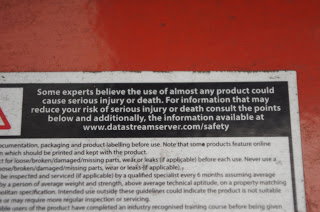 |
| Again you were warned! Use of almost any product could cause serious injury or death |
The next time you use your toothbrush, I recommend that you ponder that all encompassing warning!
Speaking of using tools, death and flies and stuff, and also to prove that love is indeed a battleground, the editor spotted a massive female huntsman spider consuming its now deceased male friend. Perhaps the male spider should have heeded the warnings?
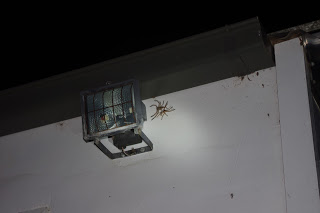 |
| A female huntsman spider consumes its now deceased male mate |
The heat has been extreme this week with most days over 32’C (90’F). The heat was combined with high humidity. In order to get some work done around the place, the editor and I have been getting up just after sunrise, starting work and then finishing around lunchtime.
After a couple of early morning mowing sessions, almost 60% of the farm has now been mowed. The prevailing weather conditions mean that the grass which was mowed a few weeks ago is now almost ready to be mowed again!
 |
| About 60% of the farm is now mowed for the summer |
Observant readers will be able to spot in the above photo, not only the little red Honda push mower, but also on the middle right hand side there is a rock circle containing a first year walnut tree. I’d given up hope on that walnut tree, but the heat combined with the humidity has caused the tree to break dormancy. It is very late in the season for a deciduous tree to break dormancy, but nature tends to ignore risks and warnings, and instead focuses its energy on producing life.
 |
| The walnut has broken its dormancy. The pin oak will have to be relocated |
Whilst I was mowing, the editor was trimming all of the garden beds along the various paths and concrete staircases. Triffid alert! Several paths and staircases were unable to be used as the plant growth had completely overtaken them. We use an electric hedge trimmer which is of course powered by the solar. The trimmer is also German, but comes with less warnings, ironically.
 |
| The garden beds on either side of pathways and concrete staircases were cut back |
Even Mr Poopy, who is sadly on a diet, now enjoys easier access to the many paths!
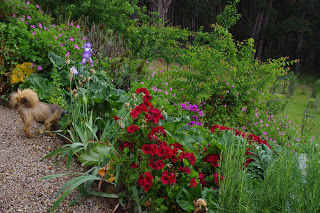 |
| Mr Poopy enjoys the now easily accessible paths |
All of the prunings are moved by hand and dumped into a developing garden bed. The prunings eventually compost down into a fine rich black soil which is perfect for garden beds. Some of the more hardy plant varieties even take root and grow as the other less hardy plants compost into soil.
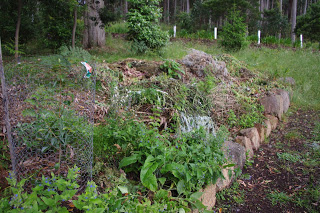 |
| Prunings are unceremoniously dumped into a developing garden bed |
Just to the left of the garden bed in the above photo, the longer established garden bed looks like this:
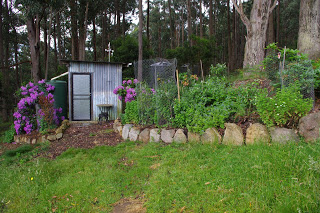 |
| A second year garden bed which is grown on composted prunings |
We also spent one very hot afternoon planting out the remainder of the summer vegetables in the tomato enclosure. In the next photo below, you can see that there was no reason at all for us to raise any tomato seedlings because nature had already taken care of that job with no effort at all on our part. Also in that enclosure are: Blueberries; Gooseberries; Chilean Guavas; Capsicum (Peppers); Chili (Jalapeno); Eggplants; Pumpkin; Melons; Corn; Beans; and Horseradish. Yum!
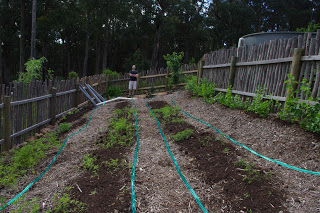 |
| The tomato enclosure was planted out with summer vegetables |
The many fruit trees are slowly producing ripening fruit and the next few photos are a sample:
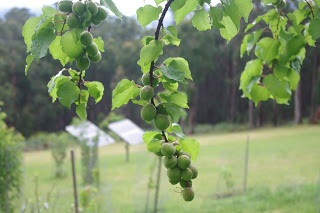 |
| Apricots are plentiful as long as the wallabies don’t first destroy the branches that are hanging heavy and within reach |
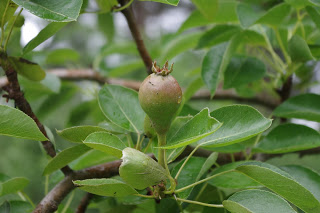 |
| This is my first summer with fruit from the slow growing European pears and I’m looking forward to tasting them |
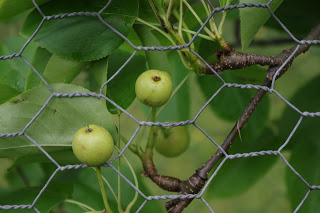 |
| Asian nashi pears are prolific and the birds will do a good job at thinning the excess fruit |
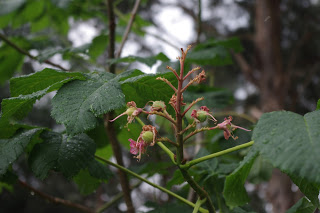 |
| The many horse chestnut flowers have turned into buckeyes which are used to produce a valuable and gentle soap |
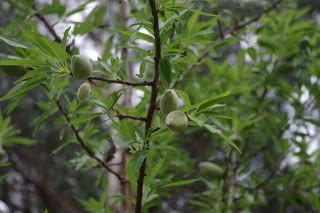 |
| Homegrown almonds are very tasty |
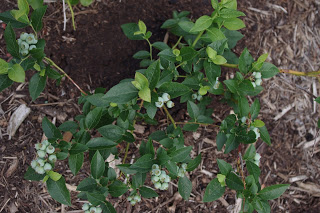 |
| Blueberries are very slow growing here and this example is only a couple of weeks away from becoming sun ripened |
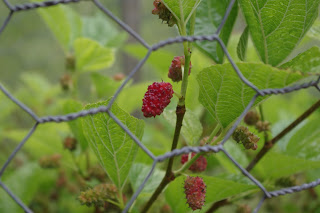 |
| I picked and ate my first ripe mulberry today! Yum! |
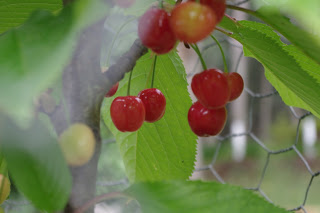 |
| The tastiest fruit at the moment are the cherries. I better get onto harvesting the early ones before the birds notice them! |
With the ongoing heat and high humidity, the triffid warning above is to be taken more seriously than any “death by washing machine”. If you don’t believe me, then check out these flower photos:
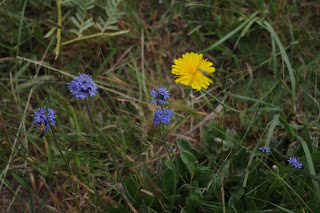 |
| Blue cornflowers are now found in the pasture below the house |
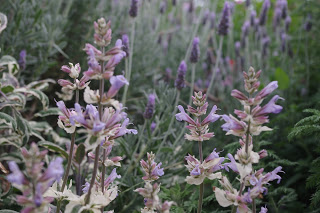 |
| The flowers for this tri-coloured sage are attractive |
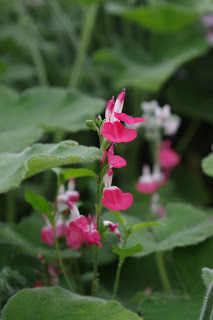 |
| Salvia’s are as delightful as they are heat and drought tough |
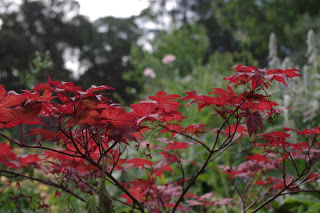 |
| The foliage on this Japanese maple is really stunning |
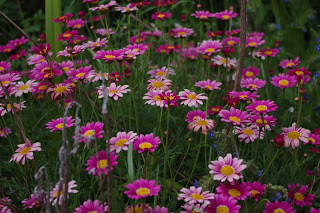 |
| Massed daisies. Nuff said! |
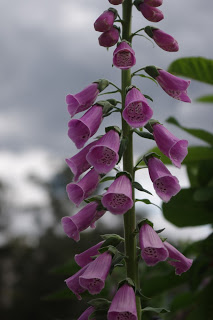 |
| This foxglove comes back in the same spot in the garden every single year |
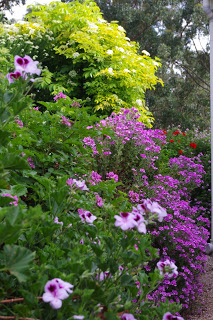 |
| Geraniums and Elderberry are a delightful and heat hardy combination |
 |
| Poppies, Pyrethrum and Granny’s Bonnets make an attractive display |
 |
| This is a plant from the Canary Islands but I am unsure what the name is. Does anyone have any ideas? |
The temperature outside now at about 8.15pm is 13’C (55’F). So far this year there has been 840.8mm (33.1 inches) which is more than last week’s total of 823.0mm (32.4 inches).
Posted by Fernglade Farm at 20:18 60 comments: ![]()
Email ThisBlogThis!Share to TwitterShare to FacebookShare to Pinterest
Monday, 20 November 2017
This blog is now available as an mp3 podcast through the link: www.ferngladefarm.com.au
I was asked a serious question the other week , “Do you have a filter for your water supply?” Whenever anyone discovers that the editor and I drink rainwater, that question is inevitably the very first one that is asked. Unsurprisingly, the person who asked the question was very dubious about the safety of the water when I replied that we don’t have a filter on the water system.
How did we as a society, get to the point where people believe that water which falls for free out of the sky as rain and stored, is somehow worse for your health than water that comes out of the municipal water supply? In order to believe such a thing, I’ve long suspected that humans in industrial societies have somehow fallen out of touch, and indeed perhaps even out of love, with the natural world.
For this blog story, I feel that we need the awesome and commanding vocals of Florence Welch of the band Florence and the Machine who penned a song about lost love titled, “No light, No light”:
Deleted
It is frankly strange to me that someone can consider that a product that contains the additives of chloride and fluoride, can possibly be considered safer to consume than the same product without those chemicals. There are good reasons that those chemicals are added to municipal water supplies and I’m not arguing with that. However, what I find strange is that some people believe that in all other circumstances, water must have those chemicals, otherwise it is somehow not safe for human consumption.
The question about the lack of a filter states an implicit assumption that unfiltered rain water is somehow unsafe. That to me reflects a fear of the natural world.
I have been considering nature recently because when it comes to water, I get to use only whatever rainfall I can catch and store. Water can be purchased and trucked here, but it is enormously expensive (edit: although cheaper than buying a new water tank). I therefore have a serious incentive to catch every single drop of rain that nature supplies and then use it wisely. By contrast, people living the city of Melbourne do not have to consider nature because there is a backup plan by way of a desalination plant. If that plant is switched on, it can produce an enormous quantity of fresh water from otherwise undrinkable and very salty sea water. The plant is an extraordinary facility, the downside of which is that it uses a huge quantity of energy and I have no idea what happens to the salt which is removed from the sea water. Mind you, it is possibly a better option than the city running out of water during a prolonged drought.
It rained a lot this week, and despite the ongoing heat and humidity, I am very happy to have all of the water tanks full to the brim. The water tanks store about 110,000 Litres (28,950 Gallons).
Anyway, despite not having a filter, nature this week has been very bountiful.
Deleted
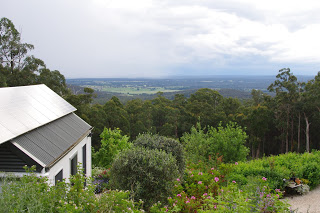 |
| Clouds gathered over the central highlands and despite the heat, heavy rain fell – and was also stored! |
From time to time, nature can teach harsh lessons, and so I can understand why people would want to put some distance between themselves and nature. Over the past year or so, the editor and I have been having problems with batches of homemade yoghurt (spelled yogurt in other places). Yoghurt is the Turkish name for a fermented milk product with its origins in South Eastern Europe and the Mediterranean. We’ve been making yoghurt for over a decade, but lately something has been going wrong and batches have been failing to set. A mates parents once amusingly informed him when he spoke with them about complexities of growing tomatoes: “It is probably better to buy them from the shop”. They may well be correct!
I’m not daunted by this challenge because whenever the word “fermented” is used, I think of Sandor Katz and his masterpiece “The Art of Fermentation”. Sandor is clearly in love with nature, and he writes about his 17 years in a rural community: “Like the spring water and garden vegetables, the fresh milk was deeply compelling to me and was part of the allure of the change of life, rural community living offered.” I’m not sure why, but he eventually moved down the road from that community into a place of his own.
Deleted
That bloke Sandor, is onto something with fermentation and so I turned to the book for advice with the yoghurt problem. Sandor describes the history and fundamentals of yoghurt making and those lessons have been very valuable. The editor is also no slouch with microbiology, and we have now eliminated most of the variables in the yogurt making process and feel that the problem may be either:
- The very expensive pasteurised milk (raw is not easily available in this country) that we purchase has somehow changed – perhaps it has a higher water content than in previous times; and/or
- The inoculum (bacterial culture) that we are using to begin the yogurt making process is derived from a laboratory culture and it is possible that a bacteriophage (a virus that kills bacteria) has evolved in our kitchen. More diverse bacterial cultures are less likely to succumb to this fate.
Time and further experimentation will sort that mess out, but in the meantime it is worth considering Sandor’s warning that: “If the existing US milk supply were to suddenly cease to be pasteurized, it would be a terrible disaster. The milk industry as we know it excels at mass production of cheap milk. In order to accomplish this, land per animal is minimized, and extraordinary means are employed … unfortunately, these methods compromise the milk’s quality and safety”. Strong words from someone who intimately knows his way around an udder.
Yoghurt problems aside, the rain fell quite heavily this week and under the verandas a number of frogs took shelter from the storm.
 |
| A Southern Brown Tree Frog consumes what appears to be a cockroach |
Proving that frogs are possibly smarter than dogs, Toothy got very wet during the storm:
 |
| Toothy the long haired dachshund got very wet during the recent storm! |
Heavy rain delayed the completion of stage 1 of the new strawberry enclosure. Eventually however the rain stopped and the clouds parted and the hot and humid weather began. So did the work! On a positive note, we were able to install the remaining chicken wire around the strawberry enclosure. About 2/3rds of a cubic metre (0.86 cubic yards) of compost were placed in nice neat rows inside the enclosure.
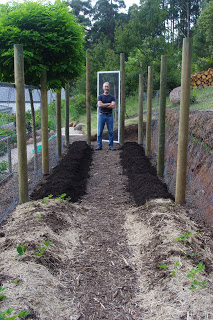 |
| Chicken wire was installed around the strawberry enclosure and compost was placed in neat rows |
The chicken wire used on the fence surrounding the enclosure was recycled from cages that previously surrounded fruit trees. It was a very fiddly and time consuming job to produce a solid fence utilising all of the very differently sized chicken cages but I love finding new uses for items that are no longer required!
The heavy duty steel chicken wire cages are very effective at stopping wallaby damage to young fruit trees. Those marsupials are expert pruners and they ensure that every lower branch is removed from every single fruit tree (as can be seen in the next photo). The job of the wallabies in the forest is to ensure that the forest remains open at ground level – and they’re very good at that job!
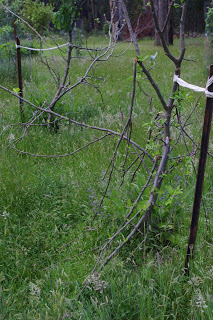 |
| Expert pruning performed by the local marsupials on a couple of apple trees |
After another couple of hours work, a further 130 odd strawberry runners were planted into the new strawberry enclosure. I even spotted a few unripe strawberries.
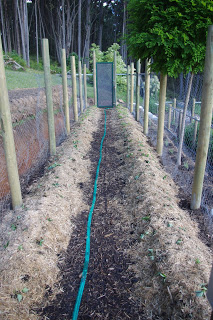 |
| A further 130 odd strawberry runners were planted into the new enclosure |
Observant readers may be able to spot the 25 lavender bushes planted just on the other side of the downhill fence. Over time, the plants will attract pollinating insects, but honestly, the lavender will just look and smell nice on a hot summers day!
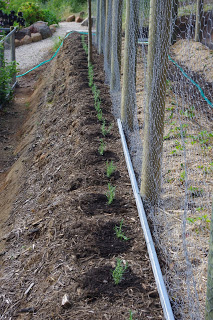 |
| 25 lavender seedlings were planted next to the strawberry enclosure |
You may be interested to see the blackberry and raspberry enclosure that sits below the strawberry terrace. It is looking great and I spotted some unripe early varieties of raspberry.
 |
| An update on the growth in the blackberry and raspberry enclosure! |
The egg crate experiment for raising seedlings hasn’t been a complete and utter total disaster, however you could almost smell the total disaster (it smells like mould) because the seedlings for fast growing plants such as tomatoes died on their first outing in great outdoors. The slower growing plants such as capsicum (peppers) and eggplants are doing far better, but next year we plant to sow directly into the soil and avoid all of this hassle (and smell). In this warm climate raising most seedlings indoors is a waste of time, and in all honesty I have no idea why I am even doing it.
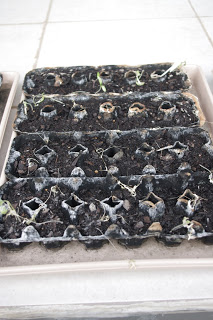 |
| The egg crate seed raising experiment was initially a great success and then a dismal failure |
This week we planted out the many cucumber and zucchini (courgette) seedlings (purchased from a non-mouldy smelling place).
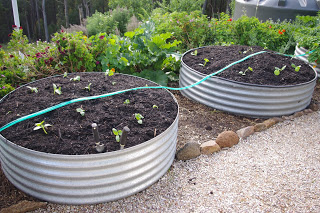 |
| Cucumber and zucchini (courgette) seedlings were planted out |
The original strawberry enclosure received a temporary stay of execution! We weeded that massive garden bed and then mulched the entire area with sugar cane mulch. If you’ve ever wondered why strawberries are so named, it is because without the straw, every single insect under the sun will consume the ripe berries!
 |
| The original strawberry enclosure received a temporary stay of execution |
Mowing continued this week and as a matter of sheer desperation, I had to cut a path through the long grass to the chicken enclosure. The path had disappeared completely in the feral spring growth – even the delightful, but incredibly sedentary Mr Poopy was getting lost in the long grass!
 |
| Mr Poopy enjoys the newly mown pathway leading to the chicken enclosure |
Late Spring Produce Update!
Someone told me that a picture tells a thousands words – so who am I to argue with them?
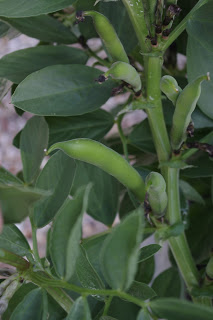 |
| We have hundreds of pods of broad beans – and may have to work out suitable recipes! |
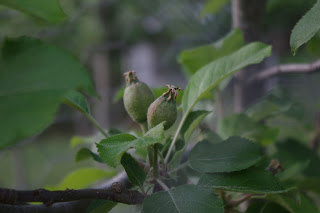 |
| Apples are getting biggerer! |
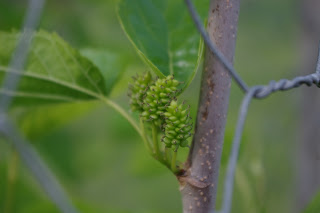 |
| I’m embarrassed to admit that I have not previously harvested the huge quantity of mulberries |
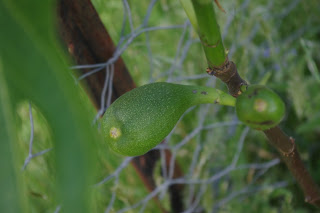 |
| The many fig trees are still young, but fruit is developing on the oldest trees |
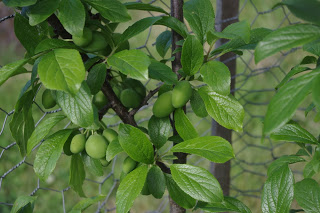 |
| As the years go on, I suspect that plums will be a staple and prolific fruit |
 |
| This years award for feral quantities of fruit goes to… Apricots! |
Late Spring Garden Update
Whenever I travel into Melbourne, I take note of the insect and bird activity in the many gardens that I walk past during my travels. Those gardens are quiet places and it is surprising to see even a lone insect hovering over a flower. As a contrast, the incessant drone from the insects in the garden beds here reminds me that they are a bit scary to venture into (be prepared to be stung or bitten!) As a backdrop to the sound of the drone from the insects is the constant chatter of the birds.
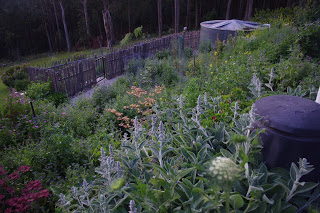 |
| The Japanese maple garden bed supports a huge variety of insect life |
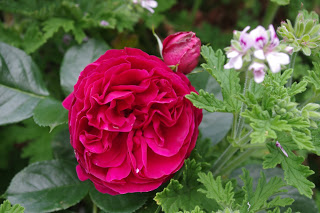 |
| Best eva! Nuff said! Smells good too (not like mould) |
 |
| Rhododendron’s are show offs! |
 |
| Another variety of Bearded Iris has produced flowers after the heavy rains earlier this week |
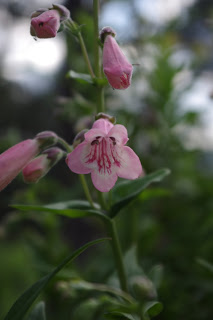 |
| The editor spotted the first of the Penstemon flowers |
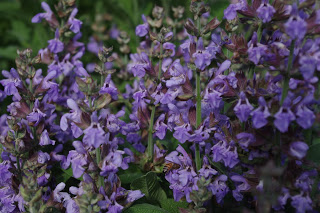 |
| Sage is feral and also a useful medicinal herb (sorts mouth ulcers right out) |
The final (almost) word this week should go to Florence Welch who really does have a truly amazing voice!
Deleted
The temperature outside now at about 9.00pm is 21’C (70’F). So far this year there has been 823.0mm (32.4 inches) which is more than last week’s total of 761.2mm (30.0 inches).
Posted by Fernglade Farm at 21:04 76 comments:
Monday, 13 November 2017
Decline of Western Civilization, Part I: Dishwashers
This blog is now available as an mp3 podcast through the link: www.ferngladefarm.com.au
A couple of decades ago some mates owned a rather amusingly titled video: The Decline of Western Civilization, Part II: The Metal Years. The film was apparently a documentary about heavy metal music. I never watched the film, or even discovered what Part I was all about. However, the amusing title, of an otherwise serious documentary video about heavy metal music caught my imagination.
Back in those days, there was no Internet. Therefore you couldn’t just type a question into an internet search engine and get a reply from a database. Nope, before the internet, a person was left with mysteries such as: What was The Decline of Western Civilization, Part I; all about? It seems like a rather important question to be left hanging in the air all uncertain and stuff. Back then, people learned to live their lives carrying around these little mysteries.
Anyway, for all I know, Part I of the documentary series, may have been a serious documentary about the banking industry. The documentary may have explored the darker sides of Collateralized Debt Obligation’s (financial instruments employed by the banking industry and which had such a large role to play in the 2008 Global Financial Crisis).
Given that Part II covered the topic of heavy metal music, then perhaps Part I of the series was most likely to have had a music theme. On a positive note for the film makers, they neatly avoided the complexities of thinking about CDO’s and the darker sides of the banking industry.
Hmm. Music theme. Well if I had to vote for a particular style of music that may positively point towards the Decline of Western Civilization, then I feel compelled to vote for the genre of “Progressive Rock”. It is not that I have any particular issue with that genre, it is just that the other day I was in the local supermarket. Over the audio system, someone had decided to play a recording from the progressive rock band The Alan Parson’s Project. The band were singing their hit from the 1970’s: “Eye in sky”. I imagine that management felt that such songs were soothing? Anyway, I didn’t feel particularly soothed. Frankly I was left wondering whether the song was a subtle reference to the many hidden cameras on the ceiling of the establishment? Who knows. I’d be much more comfortable if management decided to play, say, Sydney metal-core band: Polaris; with their song Dusk to Day, which is a lyrical account (heavy metal style of course) about one of the band members painful struggles with insomnia. Insomnia being a more relevant concern to a lot of people these days than eye’s in the sky (although drones are becoming cheaper and more available).
From time to time, I amuse myself with attempts to imagine the most absurd title for the unknown Part I of the documentary series. It is a fun game and can keep me amused for hours. As an amusing offering, I nominate: dishwashers (the automatic machine type, not the grumpy human type).
A while back someone asked me why I don’t have a dishwasher. Being a bit of a smarty pants, I replied, we do have a dishwasher – It is called Chris. That reply did not appear to satisfy the persons curiosity, so I pulled out “fluffy non-dishwasher-machine owning excuse, number six” and said: “Look mate. It’s just the solar power system here can’t run one. And it’s a bit of hassle, but, you know, we live with that hassle”. And that was that, excuse number six is a very big gun and it always brings positive results as the questions stop, and people sort of feel sorry for the editor and I.
Now, of course the solar power system can run a dishwasher. I just don’t want to install and run a dishwasher. To me those machines appear to be an inordinately expensive and polluting way to do a really simple task. Plus you can’t put crystal etc in the dishwasher. To quote the disaster film Sharknado: Nuff Said!
Here is a batch of dishes that I washed up by hand in the kitchen sink this morning:
 |
| Washing up this lot by hand must have taken me at least two minutes |
I’ve been washing up (and cooking and cleaning) since about the age of twelve. You see, my mum was a single mum, and so she was pretty busy. At that young age, one sad evening I casually sauntered into the kitchen and perhaps arrogantly dumped my soiled plates on the kitchen bench after dinner. It was at that point that I made the serious “fluffy error” of not being fast enough on my exit strategy. I got nabbed by my mum and frogmarched back towards the kitchen sink. Then after a very brief lesson, I found myself thenceforth washing dishes.
I’ve heard stories about being too busy to wash up dishes by hand, but as you can see in the story of my younger self above, that simply doesn’t match my own experience.
Back in those days, actual soap was used in the dish washing process. A normal bar of soap was placed in a wire cage with a steel handle. To create froth in the hot water, the cage was vigorously shaken for only a few moments. Alert readers will realise that this is a form of exercise! Anyway, in no time at all the water was full to bursting with bubbles and froth. With the hot soapy water available, I got to the task at hand of washing the evenings dishes and have never looked back.
In millennia to come, learned people may ponder the various reasons for the Decline of Western Civilisation and maybe one of those learned people may remark to their peers: “Here are the words of some gentleman, who writes that something called dishwashers were responsible”. And if they’re really smart then someone else may reply: “What is this dreaded dishwasher thing?”
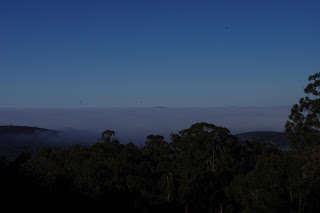 |
| It has been a hot and humid week and on some mornings fog has completely filled the valley |
The weather has been hot and humid this week. The heat combined with the high humidity has meant that the orchard has grown a lot in only a single week. Late spring is always an exciting time of the year for plant growth.
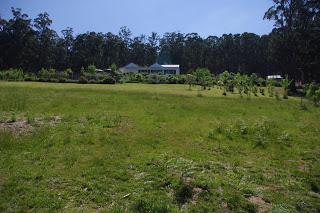 |
| The view of the house and the sunny orchard from the bottom of the paddock |
 |
| The many rhododendrons surrounding the shady orchard are producing a beautiful mass display of flowers |
The editor and I set ourselves the task this week of completing the excavations and structure for the new strawberry terrace. We didn’t quite achieve that goal, but the strawberry enclosure and terrace is looking really good and over the next few days we’ll begin the task of planting out another maybe 140 strawberry runners. Have I mentioned that we really like strawberries?
The first days excavations created another 4m (13.2ft) of terrace into the side of the hill.
 |
| The first days excavations created another 4m (13.2ft) of terrace into the side of the hill |
The second day of excavations completed that part of the job as we created a further 3m (9.9ft) of terrace.
 |
| The second day of excavations completed that part of the job as we created a further 3m (9.9ft) of terrace |
Observant readers will note in the above photo that our trusty timber stair-making-form-work makes a special guest appearance. Also, you should be able to see that the soil which was excavated over the couple of days has been used to create the beginnings of yet another terrace above this strawberry terrace. We hope to plant table grape vines on that terrace sometime in late autumn next year.
Later that afternoon, we excavated soil for the path and stair form-work, and then poured the first concrete step.
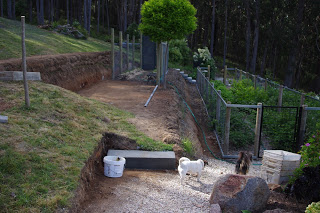 |
| The existing path was widened and the first of two concrete steps was poured |
After yet another days of hot work, the remaining seven treated pine fence posts for the strawberry enclosure were cemented into the ground. And, the second step leading up to that terrace was also poured. It is looking pretty good. Oh yeah, the door to the enclosure was also hung on one of the posts. The door came from the local tip shop. Why anyone would throw out perfectly good security doors is a mystery to me.
 |
| The second concrete step was poured and the remaining seven posts for the strawberry enclosure were set in the ground |
In the photo above, you can see that the series of terraces are in a very good location because the plant growth in the more established blackberry enclosure and terrace has been explosive in the past few weeks!
In the photos above, it is hard to see how the excavated soil from the strawberry terrace was used to begin the process of constructing yet another future terrace for table grapes above the strawberry terrace. So the next photo gives a clear idea of just how much soil has been moved by hand and compacted by foot over this past week.
 |
| Even Mr Poopy approves of the beginning stages of construction for the future table grape terrace |
As an unrelated side note, Mr Poopy is now on a serious diet which involves controlling his intake of food. His love of all things food was finally beginning to take a toll on his health. Putting him on a diet is not an easy task for a dog that is an expert forager, but hopefully forcing him to forage for his additional snacks will increase the amount of activity that he does. He is a very nice, but exceptionally lazy dog.
The serious increase in heat this week has brought out the insects. During the day, the hum and buzz from the gardens and orchard is quite loud and I have for the moment deftly avoided being stung. At night the various insects sing their night time summer chorus. All that life is a very soothing sound.
The air about the farm is full of moths and butterflies during both the night and the day:
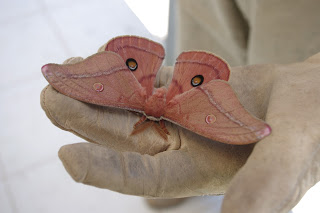 |
| The nighttime is ruled by the Bogong moths which are attracted to the house lights and gardens. They are one meaty moth (and edible too, although I have not tried this as apparently they taste like ‘moth’)! |
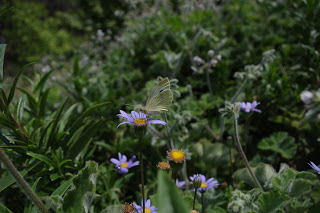 |
| During the day, moths and butterflies enjoy the many flowers |
The editor rediscovered a forgotten experiment involving Japanese maple seeds! We had placed a few seeds for those plants into one of the raised vegetable beds, and then simply forgot about them. Then the other day, the editor discovered about a dozen seedlings all happily growing without any assistance – or watering – on our part!
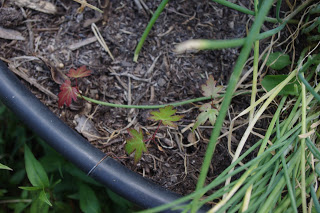 |
| A dozen forgotten Japanese maple seedlings were discovered in a raised garden bed |
It is really hard to know this week where to start with the late spring flower photos, however below is a small sample:
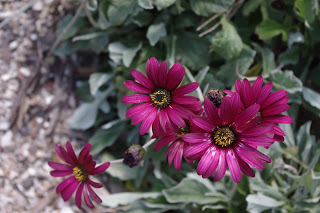 |
| Gazania’s are really hardy and cheery! |
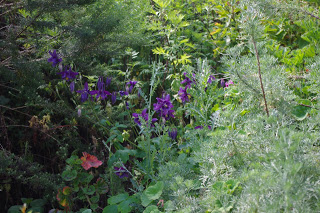 |
| A purple Granny’s Bonnet is found deep in among a Southern Wormwood and Elderberry |
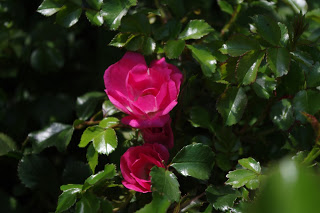 |
| This bush rose smells even more beautiful than it looks |
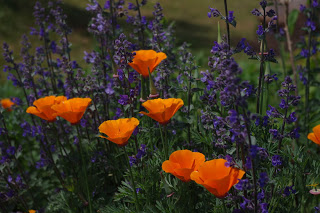 |
| Californian poppies with a background of Catmint |
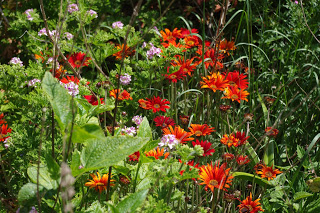 |
| More Gazania’s and Geraniums |
 |
| Nasturtiums are very hardy to heat – and a toothy salad vegetable |
The temperature outside now at about 8.45pm is 19’C (66’F). So far this year there has been 761.2mm (30.0 inches) which is more than last week’s total of 755.2mm (29.7 inches).
Posted by Fernglade Farm at 21:05
Monday, 6 November 2017
Ten to One
This blog is now available as an mp3 podcast through the link: www.ferngladefarm.com.au
I’ve never understood the act of smoking. Cigarettes were for other folks.
I’ve known quite a lot of people over the years who smoked and their complex experiences with that activity were a salient lesson which I have been careful not to repeat. The most annoying smokers that I have experienced were my older sisters. Every school holidays whilst my mother was at work, the older sisters were in charge of the household, and so they smoked inside the house. Of course, they weren’t meant to be smoking inside the house (or anywhere else for that matter), so when the clock ticked over to about 3pm, there was a mad panic to open every window in the house and air the cigarette smoke out of the house. This presented logistical problems during winter as the house became unfathomably cold.
Of course, the older sisters thought that by smoking they were cool. I knew that they were uncool because they smoked, which meant that I was cool merely by not joining in. Mind you, I probably wasn’t cool because who is cool at that age? Anyway, smoking habits aside, the older sisters used to also annoy me by playing the album colloquially known down under as: Ten to One, by the Australian band: Midnight Oil. I hated the album and the band.
With the windows of the house fully opened in the depths of winter, the stereo loudly blaring the sounds of Midnight Oil, and the in delicate fumes of cigarette smoke leaving the building, I sort of had nowhere to hide. With nowhere to hide and nothing better to do, I began listening to the music and lyrics of the band. It wasn’t long (well maybe upon reflection it was a couple of hundred repeats of the album) before I started enjoying the music. The album was revealed to me as the pure genius that it was, in an early Australian punk band sort of way.
Deleted
On Saturday night, the editor and I headed out to visit some friends. On route over on the northern side of the mountain range, we witnessed a traffic jam. There were cars everywhere, all pointing in one direction. Fortunately, we were travelling in the other direction and the traffic jam was merely a point of interest along our journey. You have to understand, other than the very strange leaf change tourism time of year (late autumn), it is a really weird thing to see a traffic jam here. It just doesn’t happen for the simple fact that there are not that many people living in this rural area.
All those vehicles in the traffic jam were heading towards Hanging Rock where the band Midnight Oil were performing.
Deleted
Observing the traffic jam that evening held a certain grim irony for me. You see I recall the lead singer of the band, Mr Peter Garrett, on one warm sweaty evening during my misspent youth exhorting to the crowd at the Forum Theatre in Melbourne, to “get out of your (a naughty word that rhymes with the word trucking) cars!” It was an impassioned call from a smart bloke. And he is a smart bloke as I believe he holds a law degree and was at one time voted into Federal politics and even (from memory) appointed as a minister of the Federal government in the role of the Environment (and later the Arts) portfolio. Long time blog readers may also recall that he is a skillful dancer.
Yet seeing all those cars in the traffic jam and on their way to the performance on Saturday night, I don’t reckon his impassioned call all those years ago, amounted to much. But then, I don’t understand why people would want to smoke either, so lots of things are a mystery to me.
Deleted
In last week’s blog I mentioned that this year we had not put away any firewood for future years. In a strange coincidence some guys that I have known for many years turned up out of the blue and offered to help us with working the forest. Long term readers will recall that despite the long working relationship with these tree dudes, things have not always been smooth. Nowadays, we haggle the price on the spot. Haggling is a rarely practiced art form in First World countries and it often involves that dirty word: Compromise. I call compromise a dirty word, because not many people appear to know how to compromise these days as they appear to want what they want! Anyway, in this instance compromise in the haggling process meant that I felt that I’d overpaid, the tree dudes felt that they were underpaid, the job got done, future plans were made, and everyone was happy, more or less.
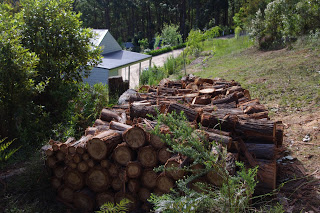 |
| The tree dudes helped with our firewood |
The editor and I then had to spend two days cleaning up the mess that the tree dudes had made. The neat wood pile in the photo above is the result of all our work.
I’ve also continued to mow the farm. Most people consider that mowing a farm is a job for a ride on mower or a tractor, but in our case we use a small Honda push mower. I get a lot of walking exercise, but on such a steep slope, it is the safest way to do the job. I’ve completed about 30% to 40% of that job.
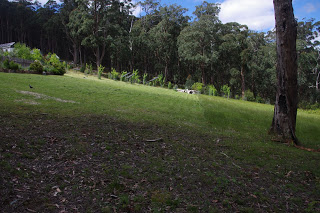 |
| The farm gets mowed by hand and the job is now about 30% to 40% complete |
Spring Vegetable Update
Pictures can tell a thousand words. Observant readers may note that I plant vegetables very closely together. Here are two of the many raised garden beds:
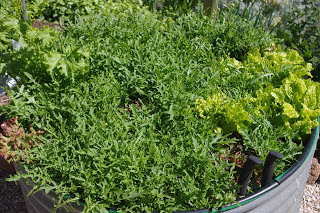 |
| A raised bed of perennial rocket, and friends |
 |
| A raised bed of various lettuce varieties as well as a green mustard |
Spring Fruit Update
Pictures can tell a thousand words. The many fruit trees appear to be producing well. Here are some of them:
 |
| Apricots are in profusion! |
 |
| Quince trees are producing their first crop this year |
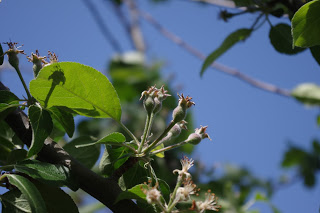 |
| It looks like it may be a good season for apples |
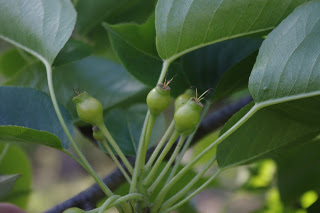 |
| Asian pears are still small but plentiful on the trees |
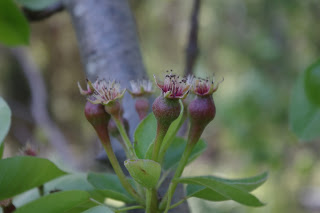 |
| European pears are much slower growing than their Asian compatriots and this is their first year of fruiting |
And it wouldn’t be a Fernglade Farm blog without sharing some of the huge collection of spring flowers from about the farm:
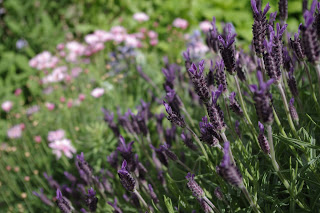 |
| Lavender enjoys the warmer spring weather |
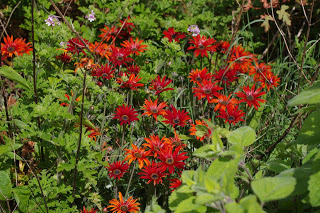 |
| How good are these Gazinia’s? |
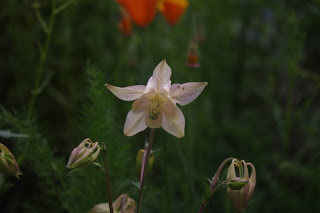 |
| We have a small collection of Granny’s Bonnet’s and they readily hybridise |
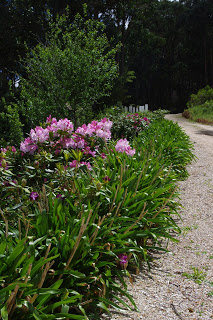 |
| The Rhododendron’s get larger and more prolific every year |
 |
| The herb garden is looking good |
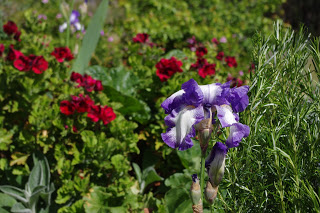 |
| It’s Iris time! |
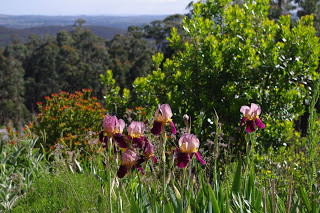 |
| After a few years Irises tend to clump and produce multiple flowers |
One of the local ferns produces an minor oddity. It is the mother shield fern, and a new plant forms on some of the frond tips. When the end of the frond reaches the ground, the new plant forms roots and gets established in that spot. Thus they walk across the landscape!
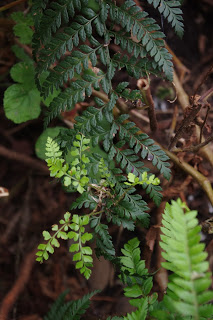 |
| A mother shield fern produces a new plant on the end of a frond |
The final word should go to Midnight Oil for their very excellent song: Short Memory
Deleted
The temperature outside now at about 10.00pm (serious Internet problems this evening!) is 7’C (44’F). So far this year there has been 755.2mm (29.7 inches) which is more than last week’s total of 738.4mm (29.1 inches).
Posted by Fernglade Farm at 22:12